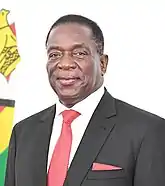List of heads of state of Zimbabwe
This is a list of the heads of state of Zimbabwe from the Unilateral Declaration of Independence (UDI) of Rhodesia in 1965 to the present day.
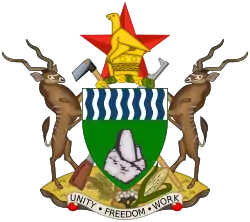 |
|---|
| This article is part of a series on the politics and government of Zimbabwe |
From 1965 to 1970 the head of state under the UDI was the Monarch in person of Elizabeth II, who simultaneously reigned as the Monarch of the United Kingdom and the other Commonwealth realms.
Ian Smith's government continued to affirm allegiance to Elizabeth II as Queen of Rhodesia from the UDI until 1970, but this was not acknowledged by the international community.
The 'Monarch' was represented in Rhodesia by the Officer Administrating of the Government, because Smith and his cabinet ignored Sir Humphrey Gibbs the Governor of Southern Rhodesia.
Rhodesia became a republic under the Constitution of 1969, adopted following the 1969 constitutional referendum, and the 'Monarch' and Officer Administrating of the Government were replaced by a ceremonial President.
Background
Initially, the territory was referred to as "South Zambezia", a reference to the River Zambezi, until the name "Rhodesia" came into use in 1895. This was in honour of Cecil Rhodes, the British empire-builder and key figure during the British expansion into southern Africa. The British government agreed that Rhodes' company, the British South Africa Company (BSAC), would administer the territory stretching from the Limpopo to Lake Tanganyika under charter as a protectorate. Queen Victoria signed the charter in 1889. The territory north of the Zambezi was the subject of separate treaties with African chiefs: today, it forms the country of Zambia. The designation "Southern Rhodesia" was first used officially in 1898 in the Southern Rhodesia Order in Council of 20 October 1898, which applied to the area south of the Zambezi,[1] and was more common after the BSAC merged the administration of the two northern territories as Northern Rhodesia in 1911.
Monarchs (1923–1970/80)
As a result of the various treaties between the BSAC and the black tribes, Acts of Parliament delineating BSAC and Crown Lands, overlapping British colonial commission authority of both areas, the rights of the increasing number of British settlers and their descendants were given secondary review by authorities. This resulted in the formation of new movements for expanding the self-government of the Rhodesian people which saw BSAC rule as an impediment to further expansion. Opinion in the United Kingdom and South Africa favoured incorporation of Southern Rhodesia in the Union of South Africa, but, by forcing the pace of negotiation, the Southern Rhodesians obtained unfavourable terms and the electorate backed Responsible Government in a 1922 referendum.
In view of the outcome of the referendum, the territory was annexed by the United Kingdom on 12 September 1923.[2][3][4][5] Shortly after annexation, on 1 October 1923, the first constitution for the new Colony of Southern Rhodesia came into force.[6][4]
| No. | Portrait | Monarch (Birth–Death) |
Reign | Royal House | Prime Minister | ||
|---|---|---|---|---|---|---|---|
| Reign start | Reign end | Duration | |||||
| 1 | 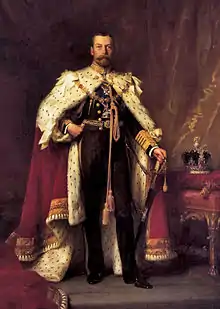 |
King George V (1865–1936) |
12 September 1923 | 20 January 1936 | 12 years, 130 days | Windsor | Coghlan Moffat Mitchell Huggins |
| 2 | 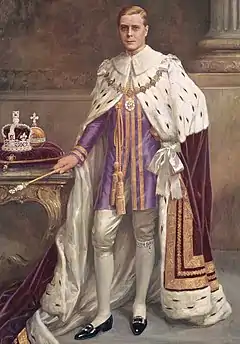 |
King Edward VIII (1894–1972) |
20 January 1936 | 11 December 1936 (abdicated.) |
326 days | Windsor | Huggins |
| 3 |  |
King George VI (1895–1952) |
11 December 1936 | 6 February 1952 | 15 years, 57 days | Windsor | Huggins |
| 4 |  |
Queen Elizabeth II (1926–) |
6 February 1952 | 2 March 1970 (de facto) 18 April 1980 (de jure) |
18 years, 24 days (de facto) 28 years, 72 days (de jure) |
Windsor | Huggins Todd Whitehead Field Smith |
On 7 October 1964 the Southern Rhodesian government announced that when Northern Rhodesia achieved independence as Zambia, the Southern Rhodesian government would officially become known as the Rhodesian Government and the colony would become known as Rhodesia.[7] On 23 October of that year, the Minister of Internal Affairs notified the Press that the Constitution would be amended to make this official. The Legislative Assembly then passed an Interpretation Bill to declare that the colony could be referred to as Rhodesia. The Bill received its third reading on 9 December 1964, and passed to the Governor for assent.
On 11 November 1965, following a brief but solemn consensus, Rhodesia's leading statesmen issued their country's Unilateral Declaration of Independence (UDI).[8][9] This was immediately denounced as an "act of rebellion against the Crown" in the United Kingdom, and Prime Minister Harold Wilson promised that the illegal action would be short-lived.[10][11] Initially, the state retained its pledged loyalty to Elizabeth II, Queen of the United Kingdom, recognizing her as Queen of Rhodesia. However, few seemed to initially realize that Rhodesia was no longer within the Commonwealth's direct sphere of influence and British rule was now a constitutional fiction; Salisbury remained virtually immune to credible metropolitan leverage.
Republic of Rhodesia (1970–1979)
During a two-proposition referendum held in 1969, the proposal for severing all remaining ties to the British Crown passed by a majority of 61,130 votes to 14,327. Rhodesia declared itself a republic on 2 March 1970.
Under the 1969 Constitution, the first constitution of the Republic of Rhodesia, the President replaced the monarch as ceremonial head of state. The President was elected by Parliament. In the event of a vacancy the President of the Senate served as Acting President.
| No. | President | Term of office Duration in years and days |
Party | Previous office | Ref. | ||
|---|---|---|---|---|---|---|---|
| 1 |  |
Clifford Dupont GCLM ID 1905–1978 |
2 March 1970 | 31 December 1975 | Rhodesian Front (RF) |
Administrator of the Government (1965–1970) |
N/A |
| 5 years and 305 days | |||||||
| – |  |
Henry Everard GCLM JCD DSO TD 1897–1980 |
31 December 1975 | 14 January 1976 | Rhodesian Front (RF) |
General Manager of Rhodesia Railways (1953–1958) |
[12] |
| 15 days | |||||||
| 2 |  |
John Wrathall GCLM ID 1913–1978 |
14 January 1976 | 31 August 1978 † | Rhodesian Front (RF) |
Minister of Finance (1964–1976) |
N/A |
| 2 years and 230 days | |||||||
| – |  |
Henry Everard GCLM JCD DSO TD 1897–1980 |
31 August 1978 | 1 November 1978 | Rhodesian Front (RF) |
General Manager of Rhodesia Railways (1953–1958) |
[12] |
| 63 days | |||||||
| – |  |
Jack William Pithey GOLM ICD CBE 1903–1987 |
1 November 1978 | 5 March 1979 | Rhodesian Front (RF) |
President of the Rhodesian Senate (1970–1979) |
N/A |
| 125 days | |||||||
| – |  |
Henry Everard GCLM JCD DSO TD 1897–1980 |
5 March 1979 | 1 June 1979 | Rhodesian Front (RF) |
General Manager of Rhodesia Railways (1953–1958) |
[12] |
| 89 days | |||||||
Zimbabwe Rhodesia (1979)
Under pressure from the international community to satisfy the civil rights movement by Blacks in Rhodesia, an "Internal Settlement" was drawn up between the Ian Smith administration of Rhodesia and moderate African nationalist parties not involved in armed resistance. Meanwhile, the government continued to battle armed resistance from both Soviet and Chinese backed Marxist liberation movements it referred to as "terrorists"- the Rhodesian Bush War was an extension of the Cold War, being a proxy conflict between the West and East, similar to those in Vietnam and Korea.
The "Internal Settlement" agreement led to relaxation of education, property and income qualifications for voter rolls, resulting in the first ever Black majority electorate. The country's civil service, judiciary, police and armed forces continued to be administered by the same officials as before, of whom most were Whites, due to the composition of the upper-middle class of the period.[13]
| No. | President | Term of office Duration in years and days |
Party | Previous office | ||
|---|---|---|---|---|---|---|
| 1 | 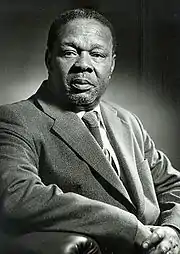 |
Josiah Zion Gumede OLG 1919–1989 |
1 June 1979 | 12 December 1979 | United African National Council (UANC) |
None |
| 195 days | ||||||
The Lancaster House Agreement stipulated that control over the country be returned to the United Kingdom in preparation for elections to be held in the spring of 1980. From 12 December 1979 to 17 April 1980, Zimbabwe Rhodesia was again the British colony of Southern Rhodesia. On 18 April 1980, Southern Rhodesia became the independent Republic of Zimbabwe.
Zimbabwe (1980–present)
| No. | Portrait | President | Took office | Left office | Time in office | Party | Election |
|---|---|---|---|---|---|---|---|
| 1 | Canaan Banana (1936–2003) | 18 April 1980 | 31 December 1987 | 7 years, 257 days | ZANU | 1980 1986 | |
| 2 | Robert Mugabe (1924–2019) | 31 December 1987 | 21 November 2017 [lower-alpha 1] | 29 years, 325 days | ZANU–PF | 1990 1996 2002 2008 2013 | |
| 3 | Emmerson Mnangagwa (born 1942) | 24 November 2017 | Incumbent | 3 years, 65 days | ZANU–PF | 2018 |
Notes
- Deposed by a coup d'état.
External links
- "Southern Rhodesia Order in Council" (PDF). rhodesia.me.uk. 1898. Archived from the original (PDF) on 2013-12-03. Retrieved 2018-07-30.
- Southern Rhodesia (Annexation) Order in Council, July 30, 1923 which provided by section 3 thereof: "From and after the coming into operation of this Order the said territories shall be annexed to and form part of His Majesty's Dominions, and shall be known as the Colony of Southern Rhodesia".
- Stella Madzibamuto v Desmond William Larder – Burke, Fredrick Phillip George (1969) A.C 645 - Authority for date of annexation having been 12 September 1923, being the date the Rhodesia (Annexation) Order in Council came into effect
- Collective Responses to Illegal Acts in International Law: United Nations Action in the Question of Southern Rhodesia by Vera Gowlland-Debbas
- Stella Madzibamuto v Desmond William Larder – Burke, Fredrick Phillip George (1969) A.C 645
- Southern Rhodesia Constitution Letters Patent 1923
- Southern Rhodesia Information Service Press Statement 980/64 A.G.C.
- Raftopolous, Brian. Becoming Zimbabwe: A History from the pre-colonial period to 2008. pp. 1–298.
- Raeburn, Michael. We are everywhere: Narratives from Rhodesian guerillas. pp. 1–209.
- "Issue 6, Spring 2011". Genocidepreventionnow.org. Retrieved 9 October 2012.
- "RHODESIA (Hansard, 21 January 1969)". Hansard.millbanksystems.com. 21 January 1969. Retrieved 9 October 2012.
- Henry Everard was never the President of the Senate
- Will We Destroy Zimbabwe-Rhodesia?, Sarasota Journal, July 18, 1979, page 4
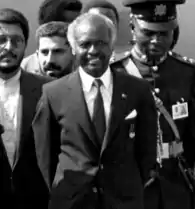
.jpg.webp)
